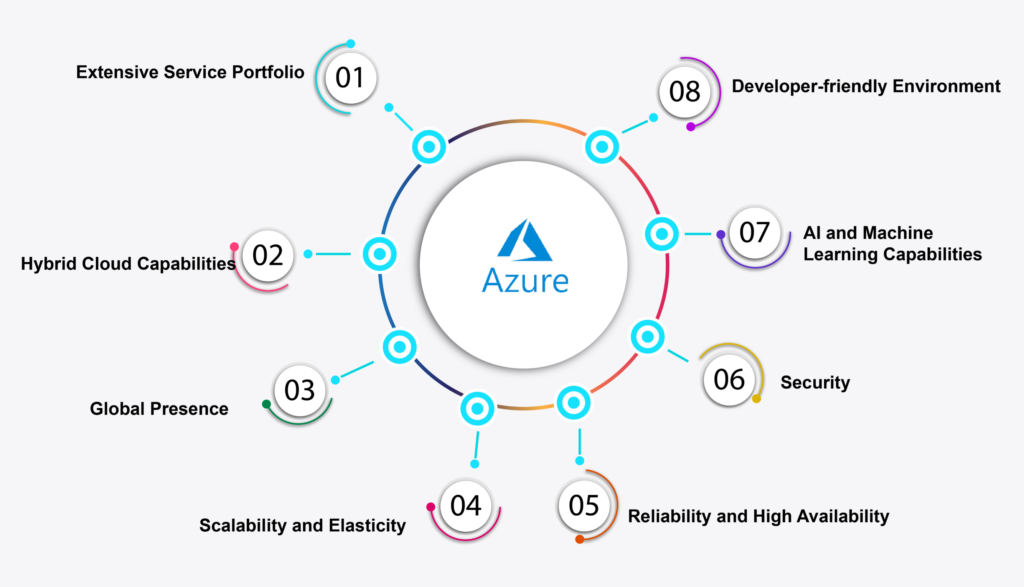
Azure is a comprehensive set of cloud services provided by Microsoft that helps businesses and organizations to build, deploy, and manage applications and services on a global scale. With Azure, companies can develop, test, and deploy their applications quickly and efficiently, while also reducing costs and increasing their scalability.
Looking for a reliable provider of Azure services? Our company offers expert Azure cloud solutions to help you build, deploy, and manage your applications and infrastructure on the Microsoft Azure platform. Our team of experienced Azure developers and consultants can assist you with Azure migration, application development, data analytics, and more. Contact us today to learn how we can help your business succeed in the cloud.
Azure is a powerful cloud platform that enables businesses to build and deploy applications and services quickly, securely, and cost-effectively. Its flexibility and scalability make it an ideal solution for companies of all sizes, from small startups to large enterprises.
OUR AZURE SERVICES

Virtual Machines

App Service

Cosmos DB

Blob Storage

Functions

Azure
Kubernetes Service

Azure
Cognitive Services

Azure DevOps
ADVANTAGES OF CHOOSING AZURE

ACHIEVING YOUR GOALS AND GROWING YOUR BUSINESS IS OUR GOAL.
ACHIEVING YOUR GOALS AND GROWING YOUR BUSINESS IS OUR GOAL.
WHY MOST AZURE FAIL OR SUCCEED?
Why Most Azure Fail?
How We Make Them Succeed With Azure!!
LACK OF PROPER PLANNING
One of the most common reasons for Azure failures is a lack of proper planning. Companies may not fully understand their workloads or fail to design their architecture appropriately. This can lead to poor performance, unexpected costs, and security vulnerabilities.
PROPER PLANNING
Develop a well-thought-out deployment plan that considers workload requirements and identifies potential issues beforehand.
INSUFFICIENT MONITORING AND MANAGEMENT
Azure is a complex system, and it requires active monitoring and management to ensure optimal performance and security. Failing to monitor and manage resources can lead to poor performance, unexpected costs, and security vulnerabilities.
ACTIVE MONITORING AND MANAGEMENT
Continuously monitor and manage resources to ensure optimal performance, security, and cost efficiency.
SECURITY VULNERABILITIES
Azure provides a high level of security, but companies must take responsibility for securing their own resources. Failing to implement proper security measures, such as role-based access control, encryption, and firewalls, can leave resources vulnerable to cyber attacks.
STRONG SECURITY MEASURES
Implement robust security measures, such as role-based access control, encryption, and firewalls, to protect resources from cyber threats.
INADEQUATE BACKUP AND DISASTER RECOVERY PLANS
While Azure provides built-in backup and disaster recovery capabilities, companies must still develop their own backup and disaster recovery plans. Failing to have adequate plans in place can result in data loss, downtime, and reputational damage.
EFFECTIVE BACKUP AND DISASTER RECOVERY PLANS
Develop and test backup and disaster recovery plans to ensure business continuity in the event of an outage or data loss.
Why Most Azure Fail?
LACK OF PROPER PLANNING
One of the most common reasons for Azure failures is a lack of proper planning. Companies may not fully understand their workloads or fail to design their architecture appropriately. This can lead to poor performance, unexpected costs, and security vulnerabilities.
INSUFFICIENT MONITORING AND MANAGEMENT
Azure is a complex system, and it requires active monitoring and management to ensure optimal performance and security. Failing to monitor and manage resources can lead to poor performance, unexpected costs, and security vulnerabilities.
SECURITY VULNERABILITIES
Azure provides a high level of security, but companies must take responsibility for securing their own resources. Failing to implement proper security measures, such as role-based access control, encryption, and firewalls, can leave resources vulnerable to cyber attacks.
INADEQUATE BACKUP AND DISASTER RECOVERY PLANS
While Azure provides built-in backup and disaster recovery capabilities, companies must still develop their own backup and disaster recovery plans. Failing to have adequate plans in place can result in data loss, downtime, and reputational damage.
How We Make Them Succeed With Azure!!
PROPER PLANNING
Develop a well-thought-out deployment plan that considers workload requirements and identifies potential issues beforehand.
ACTIVE MONITORING AND MANAGEMENT
Continuously monitor and manage resources to ensure optimal performance, security, and cost efficiency.
STRONG SECURITY MEASURES
Implement robust security measures, such as role-based access control, encryption, and firewalls, to protect resources from cyber threats.
EFFECTIVE BACKUP AND DISASTER RECOVERY PLANS
Develop and test backup and disaster recovery plans to ensure business continuity in the event of an outage or data loss.
OUR PROCESSES
We provide an Agile-based working environment to continually assess and make modifications to the website development process, according to your preferences.
Provisioning
The process of setting up and configuring Azure resources, such as virtual machines, databases, and storage accounts, to meet specific requirements.
Deployment
The process of moving code from development to production using Azure DevOps, Azure App Service, or other deployment tools.
Monitoring
The process of continuously monitoring Azure resources to detect and diagnose issues, such as poor performance, outages, or security vulnerabilities.
Scaling
The process of adjusting the capacity of Azure resources, such as virtual machines or container instances, to meet changing demand.
Security
The process of implementing and managing security measures, such as firewalls, encryption, and access control, to protect Azure resources from cyber threats.
Recovery
The process of backing up and recovering data and applications stored in Azure to ensure business continuity in the event of a disaster or data loss.
Provisioning
The process of setting up and configuring Azure resources, such as virtual machines, databases, and storage accounts, to meet specific requirements.
Deployment
The process of moving code from development to production using Azure DevOps, Azure App Service, or other deployment tools.
Monitoring
The process of continuously monitoring Azure resources to detect and diagnose issues, such as poor performance, outages, or security vulnerabilities.
Scaling
The process of adjusting the capacity of Azure resources, such as virtual machines or container instances, to meet changing demand.
Security
The process of implementing and managing security measures, such as firewalls, encryption, and access control, to protect Azure resources from cyber threats.
Recovery
The process of backing up and recovering data and applications stored in Azure to ensure business continuity in the event of a disaster or data loss.























